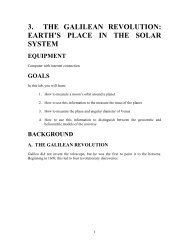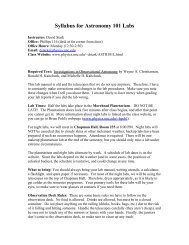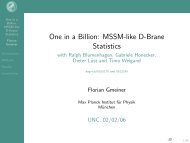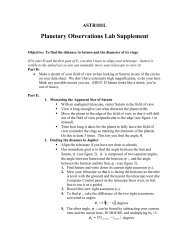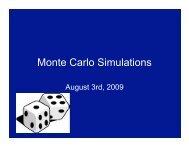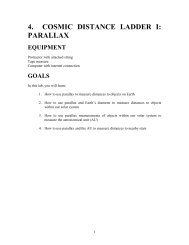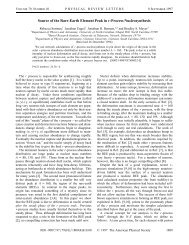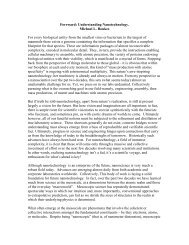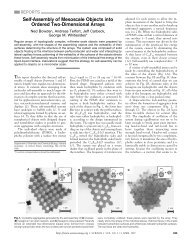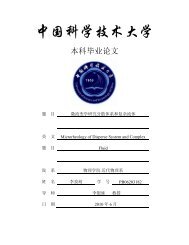Topics in Statistic Mechanics
Topics in Statistic Mechanics
Topics in Statistic Mechanics
You also want an ePaper? Increase the reach of your titles
YUMPU automatically turns print PDFs into web optimized ePapers that Google loves.
<strong>Statistic</strong>al <strong>Mechanics</strong><br />
Advanced <strong>Topics</strong> and Applications<br />
Prof. Youj<strong>in</strong> Deng, my undergraduate Advanced <strong>Statistic</strong><br />
Physics Teacher, has signed us eight modern statistical<br />
mechanics topics for survey and <strong>in</strong>vestigation purposes.<br />
These topics, show<strong>in</strong>g <strong>in</strong> the text, is quite challeng<strong>in</strong>g to<br />
a student with limited knowledge of this vast area.<br />
Li, Zimeng<br />
3/17/2012<br />
Revised Version
<strong>Topics</strong> overview<br />
1. A brief survey of percolation. Please <strong>in</strong>clude the def<strong>in</strong>ition of the percolation<br />
model, its applications, exact solution on Cayley tree, and exact solution of the<br />
percolation threshold on the square lattice.<br />
2. Exact solution of the mean-field Blume-Capel model.<br />
Please locate the l<strong>in</strong>e of the phase transitions, which is consisted of a l<strong>in</strong>e of<br />
critical po<strong>in</strong>t, a tricritical po<strong>in</strong>t, and a segment of 1st order transition. Summarize<br />
the behavior of the energy density, the specific heat, the magnetization density,<br />
the susceptibility, the vacancy density, the compressibility near the transition<br />
l<strong>in</strong>e, and as a function of temperature 1/K. Derive critical exponents.<br />
3. Is<strong>in</strong>g model is an amaz<strong>in</strong>gly beautiful toy model <strong>in</strong> statistical mechanics. Please<br />
describe the exact solution of the Is<strong>in</strong>g model <strong>in</strong> 1D (<strong>in</strong>clud<strong>in</strong>g partition sum and<br />
all observable quantities), the exact solution of the critical po<strong>in</strong>t on the square<br />
lattice. Summarize theoretical exponent for d>1. Summarize its generalization to<br />
the Potts model (ord<strong>in</strong>ary and chiral). Can you locate the critical po<strong>in</strong>t of the<br />
ord<strong>in</strong>ary Potts model on the square lattice (us<strong>in</strong>g the duality relation)?<br />
4. 4, Quantum Is<strong>in</strong>g model plays an important role <strong>in</strong> quantum statistics. Its<br />
Hamiltonian is<br />
where sigma is the Pauli matrix. Please describe its phase transition. Us<strong>in</strong>g the<br />
path-<strong>in</strong>tegral language (Suzuki-Trotter formula), a d-dimensional quantum Is<strong>in</strong>g<br />
model can be mapped onto a (d+1) dimensional quantum Is<strong>in</strong>g model. Please<br />
derive this mapp<strong>in</strong>g.<br />
5. The classical XY model is frequently used to describe the universal behavior <strong>in</strong><br />
the phase transition between Mott-<strong>in</strong>sulator and superfluidity (or<br />
superconductivity). Please give reason<strong>in</strong>g why this is possible. Summarize the<br />
phase transition of the classical XY model <strong>in</strong> 1D, 2D, 3D, and more. Give the<br />
reason<strong>in</strong>g why the 2D XY model does not have long-ranged order<strong>in</strong>g at non-zero<br />
temperature (as rigorously as possible)—Merm<strong>in</strong>-Wagner theorem.<br />
6. In real worlds, we have bosons and fermions. By <strong>in</strong>terchang<strong>in</strong>g two of such<br />
particles, the phase of the wave function accumulates 0 and PI, respectively, for
osons and fermions. Their statistical behavior obeys the Bose-E<strong>in</strong>ste<strong>in</strong> and the<br />
Fermi-Dirac statistics, respectively. Please derive them. In some 2D systems with<br />
strong <strong>in</strong>teractions, however, the excitons—psedo-particles—do not obey either<br />
of the statistics. Interchang<strong>in</strong>g two excitons can lead to a phase change of any<br />
value between 0 and 2 Pi. Such pseudo-particles are named “anyons”. They are<br />
used expla<strong>in</strong> the quantum Hall effects as well as the recently discovered<br />
quantum Sp<strong>in</strong>-Hall effects, and are found to have profound implication <strong>in</strong><br />
quantum computation. Two beautiful models for anyons are the Kitaev model<br />
and the Wen model. Please give a survey of anyons and these two models.<br />
7. Def<strong>in</strong>e the renormalization group (RG) <strong>in</strong> the language of the G<strong>in</strong>zburg-Landau<br />
model. Expla<strong>in</strong> the universality by RG. Derive the Gaussian the fixed po<strong>in</strong>t and<br />
the associated critical<br />
8. Monte Carlo method is an important tool <strong>in</strong> researches, eng<strong>in</strong>eer<strong>in</strong>g, as well as <strong>in</strong><br />
<strong>in</strong>dustries. In particular, Markovian-cha<strong>in</strong> Monte Carlo (MCMC) method is found<br />
extensive applications <strong>in</strong> statistical physics. Please give a survey of MCMC.<br />
Design your own for the 2D Is<strong>in</strong>g model; calculate energy, density, specific heat,<br />
magnetization density, and susceptibility. Locate the critical po<strong>in</strong>t, and calculate<br />
the associated critical exponents.
Index<br />
Click the title below to go to the dest<strong>in</strong>ation chapter<br />
Homework 1 Percolation<br />
1. Def<strong>in</strong>ition<br />
2. Application<br />
3. Exact Solution on Cayley Tree<br />
4. Exact Solution on Square Lattice<br />
Homework 2 Blume-Capel Model<br />
1. Def<strong>in</strong>ition<br />
1.1 Tricritical Is<strong>in</strong>g Model<br />
1.2 Blume, Emery and Griffiths (BEG) Model<br />
2. Phase Transition Diagram<br />
3. Mean Field Solution of the Blume-Capel model<br />
3.1 One Dimension Case<br />
3.2 Two Dimension Case<br />
3.3 Observable and Critical Exponents<br />
Homework 3 Is<strong>in</strong>g Model<br />
1. Describe the exact solution of Is<strong>in</strong>g model is 1D<br />
1.1 Tak<strong>in</strong>g no regard of outfield<br />
1.2 Consider<strong>in</strong>g Outfield<br />
2. The exact solution of the critical po<strong>in</strong>t on the square lattice<br />
3. Summarize the critical exponent for d>2<br />
4. Summarize the generalization of Is<strong>in</strong>g model to Potts model<br />
4.1 Ord<strong>in</strong>ary Potts model<br />
4.2 Chiral Potts model<br />
4.3 Use duality relation to locate the critical po<strong>in</strong>t of the ord<strong>in</strong>ary<br />
Potts model on square lattice<br />
Homework 4 Quantum Is<strong>in</strong>g Model<br />
1. Describe the phase transition <strong>in</strong> Quantum Is<strong>in</strong>g model<br />
1.1 Introduction to Quantum Is<strong>in</strong>g model<br />
1.2 Phase Transition <strong>in</strong> Quantum Is<strong>in</strong>g model<br />
2. Derive the mapp<strong>in</strong>g: a d dimensional quantum Is<strong>in</strong>g model can be<br />
mapped onto a d+1 dimensional classical Is<strong>in</strong>g model
3. Suzuki-Trotter Formula<br />
Homework 5 XY Model<br />
1. Def<strong>in</strong>ition<br />
2. XY Model is frequently used to describe the universal behavior of<br />
Mott-<strong>in</strong>sulator and superfluidity phase transition. Why it is possible?<br />
2.1 Mott-<strong>in</strong>sulator<br />
2.2 Hubbard Model<br />
2.3 Superfluid-<strong>in</strong>sulator transition<br />
3. Merm<strong>in</strong>-Wagner theorem - 2D XY Model has no long-ranged order<strong>in</strong>g<br />
at non-zero temperature<br />
3.1 Sp<strong>in</strong> Correlation<br />
3.2<br />
4.Summarize the phase transition of Classical XY Model <strong>in</strong> 1D,2D,3D<br />
and more<br />
4.1 1D Is<strong>in</strong>g Model<br />
4.2 2D XY Model - KT phase transition<br />
4.3 3D - Heisenberg Model<br />
Homework 6 Anyons<br />
1. Fractional <strong>Statistic</strong>s<br />
2. Kitaev model<br />
3. Wen model<br />
Homework 7 Renormalization Group<br />
1. Gauss Model<br />
1.1 Introduction<br />
1.2 Momentum Space Gauss Model<br />
1.3 Renormalization Group <strong>in</strong> Momentum Space<br />
1.4 Derive the Gaussian fix po<strong>in</strong>ts and Critical exponents<br />
2. Def<strong>in</strong>e RG <strong>in</strong> the language of G<strong>in</strong>zburg-Landau model<br />
2.1 Introduction to G<strong>in</strong>zburg-Landau Model<br />
2.2 RG solution on G-L model<br />
3. Derive the new fixed po<strong>in</strong>t <strong>in</strong> d=4- dimensions and the associated<br />
critical exponents<br />
4. Expla<strong>in</strong> the Universality by RG
Homework 8 Markovian-cha<strong>in</strong> Monte Carlo<br />
1.Introduction<br />
1.1 Simple Sampl<strong>in</strong>g<br />
1.2 Importance Sampl<strong>in</strong>g<br />
2.Markov Process<br />
3.MCMC application on 2D Is<strong>in</strong>g model<br />
Class Homework 1<br />
Class Homework 2
Adv. Sta. Phy. Homework 1 Percolation Li,Zimeng PB06203182<br />
Percolation<br />
Edited by Li,Zimeng<br />
Contents:<br />
1.Def<strong>in</strong>ition<br />
2.Application<br />
3.Exact Solution on Cayley Tree<br />
4.Exact Solution on Square Lattice<br />
The phase transition of Percolation is a typical Non-Hamiltonian System phase<br />
transition. It shows us property of cont<strong>in</strong>uous phase transition, and to some extent, <strong>in</strong><br />
deep contact with the q-state Potts Model. This article would showcase a brief survey of<br />
a Percolation Model and its applications.<br />
1.Def<strong>in</strong>ition<br />
Suppose there is a hypercubic lattice G, with sites and bonds comb<strong>in</strong><strong>in</strong>g the nearest<br />
[1] Bond Percolation<br />
The probability is p for a bond to be occupied, thus 1-p for those unoccupied.<br />
[2] Lattice Percolation<br />
The probability is p for a site to be occupied, thus 1-p for those unoccupied.<br />
In both models above, clusters are formed when nearest occupied bonds or sites are<br />
jo<strong>in</strong>ed together. We def<strong>in</strong>e P(p) as the probability that an <strong>in</strong>f<strong>in</strong>itely large cluster is<br />
formed. It is easy to see and also by computer simulation, that P(p) = 0 when p < , and<br />
p significantly <strong>in</strong>creases when it passes p , later reaches 1 when p = 1. We call pc<br />
percolation threshold. It transpires that P(p) can be seen as the analogue of the order<br />
parameter of magnetic systems, which I will not proved here, q-states Potts Model.<br />
2.Application<br />
[1]Forest Fires<br />
Percolation can be used to predict how long it takes a fire to penetrate the forest or to<br />
be ext<strong>in</strong>guished.<br />
[2]Oil Fields<br />
Percolation can be used as an idealized simple model for the distribution of oil or gas
Adv. Sta. Phy. Homework 1 Percolation Li,Zimeng PB06203182<br />
<strong>in</strong>side porous rocks <strong>in</strong> oil reservoirs.<br />
[3]Diffusion <strong>in</strong> Disordered Media<br />
Hydrogen atoms are known to diffuse through many solids, an effect which might<br />
become important for energy storage. A particularly simple disordered medium is our<br />
percolation lattice.<br />
[4]Gelation<br />
3.Exact Solution on Cayley Tree<br />
Cayley Tree<br />
Bethe lattice, or Cayley tree, have every of its sites connected with z neighbours, but<br />
none of them form loops. See Fig 3.1<br />
Fig 3.1<br />
Cayley Tree<br />
As can be seen above, there is an orig<strong>in</strong> site <strong>in</strong> the center, and around each site is its<br />
neighbours. Branches are all sites besides the orig<strong>in</strong> site, and subbranches can also be<br />
def<strong>in</strong>ed similarly, but <strong>in</strong> the branch region.<br />
therefore no wonder Cayley Tree is <strong>in</strong>f<strong>in</strong>ite dimension.<br />
To get the percolation threshold of Cayley Tree, we start from the center, follow<strong>in</strong>g the
Adv. Sta. Phy. Homework 1 Percolation Li,Zimeng PB06203182<br />
path outward, to see if an <strong>in</strong>f<strong>in</strong>itely large cluster is formed. We f<strong>in</strong>d z-1 new bonds<br />
emanat<strong>in</strong>g from every new site. So the probability that these new neighbours are<br />
occupied is p(z-1). If p(z-1)
Adv. Sta. Phy. Homework 1 Percolation Li,Zimeng PB06203182<br />
p<br />
p'<br />
a<br />
p<br />
p<br />
2a<br />
The smallest generat<strong>in</strong>g structure is the blue<br />
l<strong>in</strong>e<br />
Fig 4.1<br />
It's easily seen that p'= (4.1)<br />
Tak<strong>in</strong>g<br />
are occupied, we have<br />
as an example, referr<strong>in</strong>g to the blue l<strong>in</strong>e <strong>in</strong> Fig 4.1, if all the up bonds<br />
It the same when down bonds are all occupied. The third case is the case <strong>in</strong> Fig 4.1<br />
where the marked (with p) bond is occupied, and the case of its counterpart. Therefore<br />
we totally have 2<br />
We now search for the fixed po<strong>in</strong>t <strong>in</strong> (4.1)<br />
solutions for p<br />
Because 0
Adv. Sta. Phy. Homework 1 Percolation Li,Zimeng PB06203182<br />
1<br />
(0.5,0.5)<br />
0<br />
0 1<br />
p<br />
It's easily seen that<br />
is a unstable fixed po<strong>in</strong>t and so is the critical po<strong>in</strong>t.<br />
Therefore<br />
is the percolation threshold on square lattice.<br />
Reference<br />
1.Introduction to Percolation Theory 2nd ed - D. Stauffer, A. Aharony (T&F, 2003) WW<br />
2.Yang, Z. R. (2007). "Quantum <strong>Statistic</strong> Physics." High Education Press: 421.
Adv. Sta. Phy. Homework 2 Blume-Capel Model Li,Zimeng PB06203182<br />
Mean-Field Blume Capel Model<br />
Edited by Li, Zimeng<br />
Contents:<br />
1. Def<strong>in</strong>ition<br />
1.1 Tricritical Is<strong>in</strong>g Model<br />
1.2 Blume, Emery and Griffiths (BEG) Model<br />
2. Phase Transition Diagram<br />
3. Mean Field Solution of the Blume-Capel model<br />
3.1 One Dimension Case<br />
3.2 Two Dimension Case<br />
3.3 Observable and Critical Exponents<br />
1. Def<strong>in</strong>ition<br />
In order to <strong>in</strong>troduce <strong>in</strong> the Blume Capel Model, we would like to take a review of the<br />
tricritical Is<strong>in</strong>g model and the Blume, Emery and Griffiths (BEG) Model.<br />
1.1 Tricritical Is<strong>in</strong>g Model<br />
The first generalization of Is<strong>in</strong>g criticality is obta<strong>in</strong>ed when consider<strong>in</strong>g an Is<strong>in</strong>g<br />
antiferromagnet with Hamiltonian<br />
, where is called the staggered magnetic<br />
field.<br />
It is easily drawn that the tricritical Is<strong>in</strong>g model falls to normal Is<strong>in</strong>g Model when<br />
=0. When consider<strong>in</strong>g the Hamiltonian above fully, we can draw the phase<br />
diagram of the tricritical Is<strong>in</strong>g model.See Fig 1.1.1
Adv. Sta. Phy. Homework 2 Blume-Capel Model Li,Zimeng PB06203182<br />
Fig 1.1.1<br />
In the above diagram, the (broken) first-order l<strong>in</strong>e and the (full) l<strong>in</strong>e of Is<strong>in</strong>g critical<br />
po<strong>in</strong>ts (second-order) meet at the tricritical po<strong>in</strong>t (Bt,Tt)shown as black dot.<br />
Phase diagram of above has been realized <strong>in</strong> 3D metamagnetic systems such as Is<strong>in</strong>g<br />
model with annealed vacancies,modeled by a vacancy variable<br />
and the Hamiltonian<br />
If we def<strong>in</strong>e , which takes the value , then we obta<strong>in</strong> the Blume Capel<br />
model with Hamiltonian<br />
(1.1.1)<br />
1.2 Blume, Emery and Griffiths (BEG) Model<br />
Historically, the Blume-Capel model is a simplification of the BEG model.The sp<strong>in</strong>-1<br />
model<br />
was <strong>in</strong>troduced by Blume, Emery and Griffiths. Here<br />
J is the usual Is<strong>in</strong>g coupl<strong>in</strong>g, a is the constant of biquadratic exchange and the parameter
Adv. Sta. Phy. Homework 2 Blume-Capel Model Li,Zimeng PB06203182<br />
stand for the <strong>in</strong>teraction of the sp<strong>in</strong>s with the crystal field at each site i. If we set a=0,<br />
it becomes the Blume-Capel model (1.1.1) with B=0. Here . is well known<br />
for the normal Is<strong>in</strong>g model, while<br />
zero occupation, or the site with sp<strong>in</strong> annealed.(see Sec. 1.1)<br />
2. Phase Transition Diagram<br />
can be viewed as Is<strong>in</strong>g model with vacancies, or<br />
Consider<strong>in</strong>g<br />
with B=0. It is easily drawn that when<br />
, and the model returns to normal Is<strong>in</strong>g model because is limited value,<br />
thus the Hamiltonian is rewritten as Is<strong>in</strong>g Hamiltonian:<br />
Replace with (see Sec. 1.2), we rewrite the Hamiltonian of the simplified Blume-<br />
Capel model as:<br />
The ordered states with have energy per site , while the state with has<br />
zero energy.The ground state of an ordered state must thus guarantee the condition<br />
that , and we therefore conclude that there is a zero-temperature transition from<br />
the state with to ordered state with at . This is a first order transition, <strong>in</strong><br />
the sense that there are discont<strong>in</strong>uities <strong>in</strong> the magnetization and the derivative of the<br />
energy with respect to .Also the correlation length is zero at this po<strong>in</strong>t, s<strong>in</strong>ce there are<br />
no fluctuations.The first order transition must persist for some length s<strong>in</strong>ce there is a<br />
convergent radius for the perturbation. Therefore, along the boundary of the ordered<br />
state and the disordered state, there is a change from the first order transition to the<br />
second order transition.And the transition po<strong>in</strong>t is called the tricritical po<strong>in</strong>t.The figure is<br />
shown below: (We can compare it to the tricritical Is<strong>in</strong>g model Fig 1.1.1)
Adv. Sta. Phy. Homework 2 Blume-Capel Model Li,Zimeng PB06203182<br />
Fig 2.1<br />
3. Mean Field Solution of the Blume-Capel model<br />
Consider<strong>in</strong>g simplified Blume-Capel model Hamiltonian<br />
, where<br />
is a factor when the sum of different sites is repeated twice.<br />
3.1 One Dimension Case<br />
The central idea of mean field theory is to approximate the <strong>in</strong>teract<strong>in</strong>g case<br />
by a simpler non<strong>in</strong>teract<strong>in</strong>g partition function.<br />
We first rewrite<br />
where
Adv. Sta. Phy. Homework 2 Blume-Capel Model Li,Zimeng PB06203182<br />
Therefore the partition function can be written as<br />
, where N' is the number of sites which either sp<strong>in</strong> 1 or sp<strong>in</strong> -1 occupies.<br />
The above derivation of the last equation can be found at Homework 1.[2] <strong>in</strong> the Email<br />
package.<br />
We have free energy<br />
We can derive the critical po<strong>in</strong>t at which the free energy of the system is m<strong>in</strong>imized,<br />
when we set to zero of the derivative of the free energy with respect to M. So we have<br />
(3.1)<br />
The solution of M can be obta<strong>in</strong>ed through graphical method. See Fig 3.1
Adv. Sta. Phy. Homework 2 Blume-Capel Model Li,Zimeng PB06203182<br />
0 1 2 3<br />
Fig 3.1<br />
Alternatively, we can also draw the picture of f with respect to M to catch the critical<br />
po<strong>in</strong>t.<br />
[1] Is<strong>in</strong>g Model with<br />
When<br />
the Blume-Capel model just corresponds to Is<strong>in</strong>g model without outfield<br />
S<strong>in</strong>ce<br />
of<br />
series <strong>in</strong> x<br />
<strong>in</strong> the free energy is positive.<br />
(through Taylor expansion at M when =0)<br />
,we notice that the coefficient<br />
If<br />
, the only m<strong>in</strong>imum of free energy is at M=0, this corresponds to<br />
paramagnetic phase.<br />
If , the m<strong>in</strong>imum can be found <strong>in</strong> two places, and , which means the
Adv. Sta. Phy. Homework 2 Blume-Capel Model Li,Zimeng PB06203182<br />
symmetry is spontaneously broken. This corresponds to ordered states. See<br />
Figure below:<br />
Fig 3.2<br />
Which states ( or ) is chosen depends on how the limit of<br />
applied field will give rise to some non-zero magnetization. In the ferromagnetic phase<br />
this non-zero magnetization will survive even <strong>in</strong> the limit of<br />
, the figure is different:<br />
Fig 3.3<br />
We thus conclude there will be a first order phase transition at the po<strong>in</strong>t when<br />
is
Adv. Sta. Phy. Homework 2 Blume-Capel Model Li,Zimeng PB06203182<br />
vanished at<br />
or<br />
[2] Blume-Capel Model<br />
The Blume-Capel model is different from [1] <strong>in</strong> its additional term<br />
, which allows<br />
the coefficient of <strong>in</strong> the free energy to change sign.Therefore the coefficient of<br />
may happen to be negative, and so the above diversity of free energy with respect to M<br />
can be <strong>in</strong>terpreted <strong>in</strong> the follow<strong>in</strong>g figure:<br />
Here , similar to<br />
Fig 3.4<br />
<strong>in</strong> [1], is also the first order phase transition critical po<strong>in</strong>t. (When<br />
<strong>in</strong> the free energy vanishes)<br />
From Sec. 2 we know there is a tricritical po<strong>in</strong>t where the first order phase transition<br />
turns <strong>in</strong>to the second order phase transition. The tricritical po<strong>in</strong>t can be obta<strong>in</strong>ed when<br />
both and vanishes.<br />
3.2 Two Dimension Case<br />
We give the result here without proof. On a square lattice, the Blume-Capel model<br />
exhibits two equivalent, ferromagnetic ground states A and B, for ; and<br />
one ground state, , for . At (D/J) (with (2) = 0) the ferromagnetic phases A<br />
and B undergo an order-disorder transition which is second-order for < 1.945,<br />
tricritical for D/J 1.945 and first order for 1.945 < (d=2).
Adv. Sta. Phy. Homework 2 Blume-Capel Model Li,Zimeng PB06203182<br />
3.3 Observable and Critical Exponents<br />
Energy Density<br />
lnZ=<br />
E=<br />
Specific Heat C<br />
C=<br />
Magnetization Density<br />
(see 3.1), we can only solve it by us<strong>in</strong>g graphical method.<br />
Susceptibility<br />
To be implemented.<br />
Critical Exponents<br />
The numerical results for the tricritical po<strong>in</strong>t are for the Blume-Capel quantum sp<strong>in</strong><br />
model with<br />
= 0, = 0.910207 ,<br />
Reference<br />
1.Cardy J. Scal<strong>in</strong>g and Renormalization <strong>in</strong> <strong>Statistic</strong>al Physics (CUP, 1996)(T)(252s)<br />
2.Uzunov D.I. Introduction to theory of critical phenomena (WS)(KA)(T)(461s)<br />
3.Henkel M. Conformal <strong>in</strong>variance and critical phenomena (Spr<strong>in</strong>ger, 1999)(ISBN<br />
354065321X)(K)(T)(434s)<br />
4.Yang, Z. R. (2007). "Quantum <strong>Statistic</strong> Physics." High Education Press: 421.<br />
5.Domb C., Lebowitz J.L. (eds.) Phase Transitions and Critical Phenomena v.12 (Academic<br />
Press, 1988)(ISBN 0122203127)(T)(K)(498s)
Adv. Sta. Phy.Homework 3 Is<strong>in</strong>g Model Li,Zimeng PB06203182<br />
Is<strong>in</strong>g Model<br />
Edited by Li, Zimeng<br />
Contents:<br />
1. Describe the exact solution of Is<strong>in</strong>g model is 1D<br />
1.1 Tak<strong>in</strong>g no regard of outfield<br />
1.2 Consider<strong>in</strong>g Outfield<br />
2. The exact solution of the critical po<strong>in</strong>t on the square lattice<br />
3. Summarize the critical exponent for d>2<br />
4. Summarize the generalization of Is<strong>in</strong>g model to Potts model<br />
4.1 Ord<strong>in</strong>ary Potts model<br />
4.2 Chiral Potts model<br />
4.3 Use duality relation to locate the critical po<strong>in</strong>t of the ord<strong>in</strong>ary Potts model on<br />
square lattice<br />
1. Describe the exact solution of Is<strong>in</strong>g model is 1D<br />
1.1 Tak<strong>in</strong>g no regard of outfield<br />
[1]Tak<strong>in</strong>g free border condition<br />
Def<strong>in</strong>e<br />
,then<br />
So, Z=<br />
Correlation Function:G[N]=<<br />
is correlation length,<br />
Thus, we can plot the relation of correlation function and r or N
Adv. Sta. Phy.Homework 3 Is<strong>in</strong>g Model Li,Zimeng PB06203182<br />
1<br />
0<br />
0 2 4 6 8 10<br />
N<br />
[2] Take the period border<br />
We have<br />
Note that when T
Adv. Sta. Phy.Homework 3 Is<strong>in</strong>g Model Li,Zimeng PB06203182<br />
We will derive observables below:<br />
1. Energy<br />
(1)<br />
(2)
Adv. Sta. Phy.Homework 3 Is<strong>in</strong>g Model Li,Zimeng PB06203182<br />
(2)<br />
(3)<br />
(4)<br />
0<br />
2 4 6 8 10<br />
K<br />
2. Heat Capacity<br />
Figure 2, y:E, x: K<br />
(5)
Adv. Sta. Phy.Homework 3 Is<strong>in</strong>g Model Li,Zimeng PB06203182<br />
(5)<br />
(6)<br />
(7)<br />
(8)
Adv. Sta. Phy.Homework 3 Is<strong>in</strong>g Model Li,Zimeng PB06203182<br />
3<br />
2<br />
1<br />
0<br />
0 2 4 6 8 10<br />
Figure 3, x:K, y:C<br />
3. Correlation Function<br />
(9)<br />
(10)
Adv. Sta. Phy.Homework 3 Is<strong>in</strong>g Model Li,Zimeng PB06203182<br />
1<br />
0<br />
0 2 4 6 8 10<br />
K<br />
(11)<br />
(12)<br />
(13)
Adv. Sta. Phy.Homework 3 Is<strong>in</strong>g Model Li,Zimeng PB06203182<br />
0<br />
T<br />
So, 1 D Is<strong>in</strong>g has no phase change at none-zero temperature, or 1 D Is<strong>in</strong>g model has no<br />
phase change;<br />
4. Partition Function<br />
evaluate at po<strong>in</strong>t
Adv. Sta. Phy.Homework 3 Is<strong>in</strong>g Model Li,Zimeng PB06203182<br />
5.<br />
6.<br />
0<br />
5 6 7 8 9 10<br />
K<br />
Magnetism Intensity =0<br />
Magnetism susceptibility =0<br />
Fig 6 x:K, y:Z, N=10<br />
1.2 Consider<strong>in</strong>g Outfield<br />
1.Magnetization<br />
First we should derive the partition function by us<strong>in</strong>g the matrix method -<br />
Tak<strong>in</strong>g the periodic border condition,<br />
Z=
Adv. Sta. Phy.Homework 3 Is<strong>in</strong>g Model Li,Zimeng PB06203182<br />
Def<strong>in</strong>e matrix<br />
Then Z=tr(<br />
and P=<br />
eigenvalues<br />
(14)<br />
(15)
(15)<br />
Adv. Sta. Phy.Homework 3 Is<strong>in</strong>g Model Li,Zimeng PB06203182
Adv. Sta. Phy.Homework 3 Is<strong>in</strong>g Model Li,Zimeng PB06203182<br />
100<br />
80<br />
60<br />
40<br />
20<br />
0<br />
0 1 2 3 4 5<br />
(3)General consideration
Adv. Sta. Phy.Homework 3 Is<strong>in</strong>g Model Li,Zimeng PB06203182<br />
(16)
Adv. Sta. Phy.Homework 3 Is<strong>in</strong>g Model Li,Zimeng PB06203182<br />
18<br />
16<br />
14<br />
12<br />
10<br />
8<br />
6<br />
4<br />
2<br />
0<br />
0 2 4 6 8 10<br />
x:K, y:M<br />
2.Magnetism susceptibility<br />
3.Energy<br />
(17)
(17)<br />
Adv. Sta. Phy.Homework 3 Is<strong>in</strong>g Model Li,Zimeng PB06203182
Adv. Sta. Phy.Homework 3 Is<strong>in</strong>g Model Li,Zimeng PB06203182<br />
0<br />
1 2<br />
4.Heat Capacity<br />
differentiate w.r.t. T<br />
Fig 9 x:K, y:E
Adv. Sta. Phy.Homework 3 Is<strong>in</strong>g Model Li,Zimeng PB06203182<br />
60<br />
50<br />
40<br />
30<br />
20<br />
10<br />
0<br />
0 1 2 3<br />
Fig 10 x: K,y: C<br />
5.Correlation function G<br />
G=
Adv. Sta. Phy.Homework 3 Is<strong>in</strong>g Model Li,Zimeng PB06203182<br />
10000<br />
9000<br />
8000<br />
7000<br />
6000<br />
5000<br />
4000<br />
3000<br />
2000<br />
1000<br />
0 1 2<br />
6. Partition Function<br />
Fig 11 x:K, y:G<br />
(18)
Adv. Sta. Phy.Homework 3 Is<strong>in</strong>g Model Li,Zimeng PB06203182<br />
(19)<br />
0<br />
0 2 4 6 8 10
Adv. Sta. Phy.Homework 3 Is<strong>in</strong>g Model Li,Zimeng PB06203182<br />
Fig 12<br />
2. The exact solution of the critical po<strong>in</strong>t on the square lattice<br />
We def<strong>in</strong>e our effective Hamiltonian as<br />
We <strong>in</strong>troduce <strong>in</strong> the follow<strong>in</strong>g variables:<br />
We have ( )<br />
Therefore<br />
=<br />
So<br />
We here <strong>in</strong>troduce <strong>in</strong> the Bragg-Williams method<br />
We def<strong>in</strong>e<br />
and<br />
We therefore rewrite the effective Hamiltonian as<br />
We suppose
Adv. Sta. Phy.Homework 3 Is<strong>in</strong>g Model Li,Zimeng PB06203182<br />
We get<br />
Partition function Z=<br />
where<br />
we replace lnZ with its largest term. We use Sterl<strong>in</strong> formula and get<br />
We can f<strong>in</strong>d when will the above equation gets its largest term by deriv<strong>in</strong>g it with<br />
respect to I and set it to zero, and we get<br />
We f<strong>in</strong>d I happens to connect with M by<br />
We can solve (2.1) by diagram method.See figure below<br />
(2.1)
Adv. Sta. Phy.Homework 3 Is<strong>in</strong>g Model Li,Zimeng PB06203182<br />
2<br />
1<br />
=1.5<br />
0 1 2 3<br />
Fig 13<br />
Here we def<strong>in</strong>e<br />
We have the solution through diagram method:<br />
I=0 ( )<br />
I=<br />
It is easily seen that I=0 means there is no self-magnetization, which corresponds to<br />
high-temperature limit. I= shows there are two ordered states or ferromagnetic<br />
states <strong>in</strong> low temperature. Thus we obta<strong>in</strong> the critical temperature at
Adv. Sta. Phy.Homework 3 Is<strong>in</strong>g Model Li,Zimeng PB06203182<br />
3. Summarize the critical exponent for d>2<br />
We will use d=2 for an example here. We simplify<br />
We need to solve a transcendental equation when try<strong>in</strong>g to obta<strong>in</strong> L(def<strong>in</strong>ition see<br />
below)<br />
Especially when there is no outfield, we have<br />
evaluate at po<strong>in</strong>t<br />
evaluate at po<strong>in</strong>t
Adv. Sta. Phy.Homework 3 Is<strong>in</strong>g Model Li,Zimeng PB06203182<br />
2<br />
1<br />
=1.5<br />
0 1 2 3<br />
L<br />
Fig 14 x:L, y: tanh(KL)<br />
, we have
Adv. Sta. Phy.Homework 3 Is<strong>in</strong>g Model Li,Zimeng PB06203182<br />
1<br />
L<br />
0<br />
0 1<br />
W<br />
Fig 15 x: A=<br />
We have<br />
Partition Function has the follow<strong>in</strong>g expression:<br />
number,W is magnetism energy and J is the energy of sp<strong>in</strong> <strong>in</strong>teraction.<br />
T>
Adv. Sta. Phy.Homework 3 Is<strong>in</strong>g Model Li,Zimeng PB06203182<br />
C=<br />
Therefore, heat capacity experience mutation at<br />
When there exists outfield, the transcendental equation is L=tanh<br />
M=<br />
4. Summarize the generalization of Is<strong>in</strong>g model to Potts model<br />
4.1 Ord<strong>in</strong>ary Potts model<br />
The difference of q-states Potts model to Is<strong>in</strong>g model is that it allow to take q different<br />
values on each site<br />
The Is<strong>in</strong>g model is recovered if q=2. Def<strong>in</strong><strong>in</strong>g<br />
, we have
Adv. Sta. Phy.Homework 3 Is<strong>in</strong>g Model Li,Zimeng PB06203182<br />
and, up to a multiplicative factor <strong>in</strong> the coupl<strong>in</strong>g J and a trivial<br />
additive constant, the Is<strong>in</strong>g Hamiltonian<br />
recovers.<br />
4.2 Chiral Potts model<br />
A variant of q-states model is the clock model, but which is equivalent to the q-state<br />
Potts model only for q=2,3. The clock model is def<strong>in</strong>ed as<br />
An variant of the clock model is the chiral Potts model, which sometimes is referred to<br />
as asymmetric clock model. The Hamiltonian is given as<br />
where (i,i')labels the po<strong>in</strong>ts on the square lattice and<br />
are free parameters.<br />
4.3 Use duality relation to locate the critical po<strong>in</strong>t of the ord<strong>in</strong>ary Potts model on<br />
square lattice<br />
In q-states model, there is a disordered high-temperature phase and an ordered lowtemperature<br />
phase. They are related through a duality transformation. The partition<br />
function can be written as<br />
Consider<strong>in</strong>g a square lattice with N sites, we can calculate the contribution of <strong>in</strong>dividual<br />
sp<strong>in</strong> configuration <strong>in</strong> (4.3.1) <strong>in</strong> a graphical way. We draw a bond between nearest sites i<br />
and i' if each of them is occupied with a variable and . We def<strong>in</strong>e the above<br />
configuration as graph G, and def<strong>in</strong>e b(G) as the number of bonds <strong>in</strong> G. We therefore<br />
have the contribution to the partition function as<br />
The sum over all configurations can be rewritten as<br />
, where the second sum<br />
refers to possible values of<br />
<strong>in</strong> a given cluster of G. We def<strong>in</strong>e n(G) as the number of<br />
disconnected nearest neighbours <strong>in</strong> the graph G, and so the second sum simply produce
Adv. Sta. Phy.Homework 3 Is<strong>in</strong>g Model Li,Zimeng PB06203182<br />
a factor<br />
Therefore Z=<br />
Now we <strong>in</strong>troduce <strong>in</strong> a dual lattice and dual bonds.See figure below.<br />
Fig 16<br />
The black dots are normal sites and the open dots are dual sites. Full l<strong>in</strong>es make up<br />
graph G, and broken l<strong>in</strong>es make up dual graph D. Note that the dual bond does not<br />
<strong>in</strong>tersect with a bond of G.We def<strong>in</strong>e c(G) the number of loops <strong>in</strong> graph G and it's easily<br />
seen that each such loop would encircle a dual site. Each dual loop also encircles a<br />
normal site. We thus have<br />
The Euler relation says that for any graph<br />
number of sites <strong>in</strong> graph G<br />
, where N is the<br />
We def<strong>in</strong>e the total number of bonds is B=b(G)+b(D), and as the number of sites <strong>in</strong><br />
graph D<br />
Therefore the partition function can be written <strong>in</strong> the language of dual graphs<br />
, we have B=2N, N= ,therefore we have
Adv. Sta. Phy.Homework 3 Is<strong>in</strong>g Model Li,Zimeng PB06203182<br />
Thus we can proof the self-duality relation<br />
where<br />
(4.3.2)<br />
Any s<strong>in</strong>gularity occurr<strong>in</strong>g <strong>in</strong> a thermodynamic quantity at a critical po<strong>in</strong>t<br />
is mapped<br />
through the duality transformation to another coupl<strong>in</strong>g .And the critical po<strong>in</strong>t<br />
must be at the fixed po<strong>in</strong>t of the duality transformation. We thus solve the fixed po<strong>in</strong>t of<br />
(4.3.2) and get<br />
The critical po<strong>in</strong>t is thus at<br />
Reference<br />
1.Zhou,Z.F., Chao,L.Z.(2008). "Thermology, Thermodynamics and <strong>Statistic</strong> Physics"<br />
Science Press:231.<br />
2.Yang, Z. R. (2007). "Quantum <strong>Statistic</strong> Physics." High Education Press: 421.<br />
3.Henkel M. Conformal <strong>in</strong>variance and critical phenomena (Spr<strong>in</strong>ger, 1999)(ISBN<br />
354065321X)(K)(T)(434s)
Adv. Sta. Phy. Homework 4 Quantum Is<strong>in</strong>g model Li,Zimeng PB06203182<br />
Quantum Is<strong>in</strong>g Model<br />
Edited by Li, Zimeng<br />
Contents:<br />
1.Describe the phase transition <strong>in</strong> Quantum Is<strong>in</strong>g model<br />
1.1 Introduction to Quantum Is<strong>in</strong>g model<br />
1.2 Phase Transition <strong>in</strong> Quantum Is<strong>in</strong>g model<br />
2.Derive the mapp<strong>in</strong>g: a d dimensional quantum Is<strong>in</strong>g model can be mapped onto a<br />
d+1 dimensional classical Is<strong>in</strong>g model.<br />
3.Suzuki-Trotter Formula<br />
1.Describe the phase transition <strong>in</strong> Quantum Is<strong>in</strong>g model<br />
1.1 Introduction to Quantum Is<strong>in</strong>g model<br />
Quantum Is<strong>in</strong>g model is the extension of Is<strong>in</strong>g model to quantum situations, also a<br />
member of quantum sp<strong>in</strong> model family.<br />
1D quantum Is<strong>in</strong>g model is also called quantum Is<strong>in</strong>g cha<strong>in</strong>. Instead of s<strong>in</strong>gle sp<strong>in</strong><br />
direction <strong>in</strong> normal Is<strong>in</strong>g model, the quantum Is<strong>in</strong>g model uses three Pauli Matrixes to<br />
replace sp<strong>in</strong> s ( .Similar to Is<strong>in</strong>g model, we can def<strong>in</strong>e the Hamiltonian <strong>in</strong> Quantum<br />
Is<strong>in</strong>g model:<br />
where J>0 and<br />
is a dimensionless coupl<strong>in</strong>g constant.<br />
1.2 Phase Transition <strong>in</strong> Quantum Is<strong>in</strong>g model<br />
It can be shown through RG method that for non-zero temperatures, the critical<br />
behavior of the quantum Is<strong>in</strong>g model reduces to the classical Is<strong>in</strong>g Hamiltonian. For T =<br />
0, however, quantum effects do become important and must be <strong>in</strong>cluded <strong>in</strong> the analysis.<br />
We are not go<strong>in</strong>g to describe the f<strong>in</strong>ite-temperature phase transition here, but rather<br />
describe second-order phase transition at absolute zero temperature, where we can<br />
catch how a strong quantum effect modulates the phase transition.<br />
In the thermodynamic limit N , the ground state of exhibits a second order<br />
phase transition as g cross over a critical value ,we will illustrate below how to get the<br />
critical po<strong>in</strong>t of the phase transition.<br />
First, consider the ground state for<br />
ferromagnetic state.<br />
, when g=0, we have two degenerate
Adv. Sta. Phy. Homework 4 Quantum Is<strong>in</strong>g model Li,Zimeng PB06203182<br />
We def<strong>in</strong>e the ferromagnetic moment =-<br />
At g=0 we have<br />
, and even <strong>in</strong> the thermodynamic limit, this ground state still<br />
survives for a small range of g ( ), but with .This can be proved by<br />
perturbation theory, and is also similar to the extension of first order l<strong>in</strong>e <strong>in</strong> the<br />
tricritical Is<strong>in</strong>g model.(see Homework Blume-Capel Model Sec.2) Therefore the two<br />
ferromagnetic ground state rema<strong>in</strong>s and are still 2-fold degenerate.We notice that the<br />
symmetry is broken as the state is divided <strong>in</strong>to two <strong>in</strong>dependent state and<br />
Now consider the ground state for g ,when g= , we have a s<strong>in</strong>gle nondegenerate<br />
ground state which mix and (thus preserv<strong>in</strong>g all symmetries), the state is<br />
written as<br />
We can verify that this state has no ferromagnetic moment (which is <strong>in</strong> z direction):<br />
Similar to the case of , the ground state is preserved for a f<strong>in</strong>ite range of large g (g<br />
),we can view this ground state as a result of strong quantum fluctuations, as the<br />
mixed state shows quantum tunnel<strong>in</strong>g between sp<strong>in</strong> up and sp<strong>in</strong> down.<br />
Therefore, the very different ground states of and <strong>in</strong>dicates that the<br />
ground state cannot evolve smoothly as a function of g. There must be s<strong>in</strong>gularity at<br />
some po<strong>in</strong>t as a function of g for the quantum Hamiltonian, and g=1 is the nonanlytical<br />
po<strong>in</strong>t.<br />
We thereby conclude the critical po<strong>in</strong>t for the second order quantum phase transition at<br />
g=<br />
2.Derive the mapp<strong>in</strong>g: a d dimensional quantum Is<strong>in</strong>g model can be mapped onto a<br />
d+1 dimensional classical Is<strong>in</strong>g model.<br />
The mapp<strong>in</strong>g is a bridge between quantum field theory and classical statistic physics.We<br />
shall see below how quantum quantities is connected with statistic quantities.
Adv. Sta. Phy. Homework 4 Quantum Is<strong>in</strong>g model Li,Zimeng PB06203182<br />
Consider<strong>in</strong>g a quantum mechanical d dimensional system, we def<strong>in</strong>e the time-evolution<br />
operator<br />
Now take the time difference between t' and t to be <strong>in</strong>f<strong>in</strong>itesimal, and we can write the<br />
transition amplitude between via the Feynman path <strong>in</strong>tegral<br />
The above path <strong>in</strong>tegral language is based on the Suzuki-Trotter formula (see Sec.3). We<br />
can use it <strong>in</strong> quantum field theory to solve quantum Is<strong>in</strong>g cha<strong>in</strong> problems. A most<br />
common method is the Landao G<strong>in</strong>zburg Wilson method or LGW method. In Sec. 1.2, we<br />
have given a simple description of states when and . In order to discuss<br />
phenomena around the critical po<strong>in</strong>t, we have to turn to region of .<br />
Follow<strong>in</strong>g the LGW strategy, we have to first identify an order parameter, which<br />
dist<strong>in</strong>guishes the two very different ground phases described <strong>in</strong> Sec.1.2. This order<br />
parameter is just ferromagnetic moment (see Sec.1.2). Us<strong>in</strong>g coarse gra<strong>in</strong> strategies<br />
<strong>in</strong> RG method,we coarse-gra<strong>in</strong> these moments over some f<strong>in</strong>ite averag<strong>in</strong>g region, and at<br />
long wavelengths this yields a real order parameter field a measure of the local<br />
average of as def<strong>in</strong>ed <strong>in</strong> Sec.1.2.<br />
The second step of LGW method is to write down a general field theory for the order<br />
parameter.As we are deal<strong>in</strong>g with a quantum transition,the field theory has to extend<br />
over spacetime, with the temporal fluctuations represent<strong>in</strong>g the sum over histories <strong>in</strong><br />
the Feynman path-<strong>in</strong>tegral approach. Thus we will write down (2.1) as the needed field<br />
theory, with the Hamiltonian replaced by the Landao G<strong>in</strong>zburg Wilson Hamiltonian. We<br />
shall note that the <strong>in</strong>tegration above is d+1 spacetime (+1 is the time dimension)<br />
dimensional where Is<strong>in</strong>g model corresponds to d=1 case, although it is a d dimensional<br />
quantum model.
Adv. Sta. Phy. Homework 4 Quantum Is<strong>in</strong>g model Li,Zimeng PB06203182<br />
We will now show how the above functional <strong>in</strong>tegral is connected with analogous<br />
expressions <strong>in</strong> the language of statistic mechanics.<br />
We consider a statistical system on a d+1 dimensions hypercubic lattice, and def<strong>in</strong>e one<br />
of its dimension as time and the other d dimensions as space.<br />
Consider two times and their time-dependent Is<strong>in</strong>g sp<strong>in</strong>s, the transfer matrix<br />
l<strong>in</strong>ks the two configurations and has the elements:<br />
The partition function Z can thus be written:<br />
Z=<br />
(2.2)<br />
where M is the number of sites <strong>in</strong> time direction and periodic boundary condition |<br />
is assumed.<br />
Compare the transition amplitude <strong>in</strong> (2.1) and the partition function <strong>in</strong> (2.2), we can<br />
write the correspondence between statistic physics and quantum mechanics.<br />
We have<br />
which the quantum Hamiltonian is def<strong>in</strong>ed.<br />
Therefore we obta<strong>in</strong> a map of a d+1 dimensional problem with classical variables onto a<br />
d dimensional problem with quantum variables.<br />
3.Suzuki-Trotter Formula<br />
In the derivation of (2.1), we have used the Suzuki-Trotter Formula, which we will<br />
illustrate below:<br />
The path <strong>in</strong>tegral arises from the fact that (3.1)
Adv. Sta. Phy. Homework 4 Quantum Is<strong>in</strong>g model Li,Zimeng PB06203182<br />
The propaganda operator is the Green function<br />
use (3.1) to rewrite it as<br />
and we<br />
(3.2)<br />
We can prove that<br />
The correspondence between (3.2) and (3.3) is just one example of Suzuki-Trotter<br />
Formula.We are not go<strong>in</strong>g to derive (3.3) from (3.2) here, as we have learned it <strong>in</strong> the<br />
Advanced Quantum <strong>Mechanics</strong> Course.However I would like to give the def<strong>in</strong>ition of<br />
general Suzuki-Trotter Formula below:<br />
THEOREM: (Suzuki-Trotter Formula) Let A and be l<strong>in</strong>ear operators on a Banach space X<br />
such that , and A+B are the <strong>in</strong>f<strong>in</strong>itesimal<br />
generators of the contraction semigroups , , and respectively. Then for all<br />
we have<br />
Reference<br />
1.Françoise J., Naber G., Tsun T.S."Encyclopedia of Mathematical Physics; Elsevier; 2006"<br />
(3246)<br />
2.Henkel M. Conformal <strong>in</strong>variance and critical phenomena (Spr<strong>in</strong>ger, 1999)(ISBN<br />
354065321X)(K)(T)(434s)<br />
3.Techniques and applications of path <strong>in</strong>tegration (Wiley, 1981 Schulman L.S. 375s)
Adv. Sta. Phy. Homework 5 XY Model Li,Zimeng PB06203182<br />
XY Model<br />
Edited by Li,Zimeng<br />
Contents:<br />
1.Def<strong>in</strong>ition<br />
2.XY Model is frequently used to describe the universal behavior of Mott-<strong>in</strong>sulator and<br />
superfluidity phase transition. Why it is possible?<br />
2.1 Mott-<strong>in</strong>sulator<br />
2.2 Hubbard Model<br />
2.3 Superfluid-<strong>in</strong>sulator transition<br />
3.Merm<strong>in</strong>-Wagner theorem - 2D XY Model has no long-ranged order<strong>in</strong>g at non-zero<br />
temperature<br />
3.1 Sp<strong>in</strong> Correlation<br />
3.2<br />
4.Summarize the phase transition of Classical XY Model <strong>in</strong> 1D,2D,3D and more<br />
4.1 1D Is<strong>in</strong>g Model<br />
4.2 2D XY Model - KT phase transition<br />
4.3 3D - Heisenberg Model<br />
1.Def<strong>in</strong>ition<br />
XY Model is a cont<strong>in</strong>uous sp<strong>in</strong> system with its sp<strong>in</strong> s=(sx,sy), so it is a two-dimensional<br />
sp<strong>in</strong> system with its two order parameters (n=2). This type of system (d=2, n=2) is called<br />
KT phase transition.<br />
First we def<strong>in</strong>e , and here is the phase angle. Thus we can conclude the<br />
Hamiltonian for XY Model:<br />
(1.1)<br />
Here the sum is counted so that i,j is not repeated, otherwise we have to multiply a<br />
factor ahead of (1.1)<br />
Because the sum is calculated with<strong>in</strong> the nearest neighbours, therefore we can expand
Adv. Sta. Phy. Homework 5 XY Model Li,Zimeng PB06203182<br />
and so H= (1.2)<br />
There are two parts <strong>in</strong> the above equation, the first part is irrelevant to sp<strong>in</strong>, and we will<br />
omit it later. The second part can be transformed <strong>in</strong>to cont<strong>in</strong>uous form by the follow<strong>in</strong>g<br />
steps:<br />
Def<strong>in</strong>e ,<br />
therefore<br />
2.XY Model is frequently used to describe the universal behavior of Mott-<strong>in</strong>sulator and<br />
superfluidity phase transition. Why it is possible?<br />
2.1 Mott-<strong>in</strong>sulator<br />
The first successful theory to describe the metals,<strong>in</strong>sulators and transition between<br />
them is the non<strong>in</strong>teract<strong>in</strong>g electron theory. This theory, or band theory, says that<br />
<strong>in</strong>sulators have their highest fill<strong>in</strong>g band fully filled, and metals are just partially filled.<br />
But this theory failed to describe some metals and <strong>in</strong>sulators that contradict the stated<br />
band fill<strong>in</strong>g. And later we found that electron-electron correlation, or the strong<br />
Coulomb repulsion of the fill<strong>in</strong>g electrons cannot be ignored, which leads to Mott's<br />
theory and the word - Mott <strong>in</strong>sulator - to describe strong Coulomb repulsion state. The<br />
transition between metals and <strong>in</strong>sulators is called MIT or Metal Insulator Transition.<br />
In Mott's op<strong>in</strong>ion, a large Coulomb repulsion would split the band <strong>in</strong> two. The lower<br />
band consists of electrons that occupy empty sites with each site one electron, while the<br />
upper band consists of sites fully filled by electrons. Thus the lower band would be full<br />
and leads to an <strong>in</strong>sulator.<br />
2.2 Hubbard Model<br />
A prototype of theoretical understand<strong>in</strong>g of MIT is the Hubbard model, which simplifies<br />
that electrons are only <strong>in</strong> a s<strong>in</strong>gle band. Two most important parameters <strong>in</strong> Hubbard<br />
model is the correlation length U/t and the fill<strong>in</strong>g n, see Fig 2.2.1 below
Adv. Sta. Phy. Homework 5 XY Model Li,Zimeng PB06203182<br />
Fig 2.2.1<br />
There are two modes of the transition, the first one is fill<strong>in</strong>g-control MIT, or FC-MIT; And<br />
the second one, BC-MIT or band-control MIT is another case. We are not go<strong>in</strong>g to dip<br />
<strong>in</strong>to the transitions here, but will take a look at how XY Model connects with the Mott<br />
<strong>in</strong>sulator. U and t <strong>in</strong> the above figure will be def<strong>in</strong>ed below.<br />
The Hamiltonian of the Hubbard Model <strong>in</strong> the second-quantized form is given by (where<br />
we def<strong>in</strong>e two wave operators - on site i and on site j)<br />
, (2.2.1)<br />
N=<br />
So<br />
is the k<strong>in</strong>etic part and U is the Coulomb potential. From the above Hamiltonian,
Adv. Sta. Phy. Homework 5 XY Model Li,Zimeng PB06203182<br />
we can see Hubbard Model takes tremendous simplifications. It only takes <strong>in</strong>to<br />
<strong>in</strong>teract<strong>in</strong>g of the nearest neighbours, and neglects multiband effect. However, it still<br />
works f<strong>in</strong>e with MIT transitions and the Mott <strong>in</strong>sulat<strong>in</strong>g phase.As we have stated before<br />
(see Sec. 2.1), the Mott <strong>in</strong>sulat<strong>in</strong>g phase appears only at half fill<strong>in</strong>g sites.For the nearestneighbour<br />
Hubbard model on a hypercubic lattice, the band structure of the<br />
non<strong>in</strong>teract<strong>in</strong>g part is described as (see to (2.2.1))<br />
(2.2.2)<br />
We have used Fourier transform <strong>in</strong> the above derivation.<br />
Therefore, the parameters <strong>in</strong> the Hamiltonian depend on the direction of i-j. We<br />
compare (1.1) with (2.2.2), and thus we conclude that Mott-<strong>in</strong>sulator can be described<br />
by XY model.<br />
Note the Hubbard Model here has ignored degeneracy of both obitals' and sp<strong>in</strong>s'.It<br />
comes <strong>in</strong>to degenerat<strong>in</strong>g Hubbard Model when <strong>in</strong>troduc<strong>in</strong>g <strong>in</strong> obital and sp<strong>in</strong> freedoms.<br />
To <strong>in</strong>troduce <strong>in</strong> the sp<strong>in</strong> <strong>in</strong>teraction, we just need to multiply the orig<strong>in</strong>al Hubbard<br />
Hamiltonian with<br />
the sp<strong>in</strong> exchange also easily occurs.<br />
. It should be noted here that XY type or Is<strong>in</strong>g type anisotropy for<br />
2.3 Superfluid-<strong>in</strong>sulator transition<br />
The situation for bosonic superfluid-<strong>in</strong>sulator transition is simpler than the fermionic<br />
Mott-<strong>in</strong>sulator transition, similar to the Hubbard Model, we can write the Hamiltonian<br />
for the <strong>in</strong>teract<strong>in</strong>g bosons as follows (with boson operators<br />
this time)<br />
b<br />
Similar to Fig 2.2.1, the system undergoes bandwidth-control phase transition from<br />
Mott <strong>in</strong>sulator to superfluid when U/t is changed. Also, when U is large, the Mott
Adv. Sta. Phy. Homework 5 XY Model Li,Zimeng PB06203182<br />
<strong>in</strong>sulat<strong>in</strong>g phase appears similarly to the fermionic case.<br />
We can use path <strong>in</strong>tegral method to solve the criticality. First we write down the action<br />
Similar to the derivation of Hubbard model, the above action can be mapped <strong>in</strong>to d+1<br />
dimensional XY model. So the universality of superfluid-<strong>in</strong>sulator transition can also be<br />
described by XY model.<br />
3.Merm<strong>in</strong>-Wagner theorem - 2D XY Model has no long-ranged order<strong>in</strong>g at non-zero<br />
temperature<br />
3.1 Sp<strong>in</strong> Correlation<br />
To demonstrate the above theorem, we first look at the correlation of the sp<strong>in</strong>s<br />
between two sites:<br />
and we can demonstrate that this equals to<br />
Proof:<br />
In order to demonstrate it, first we can draw from the second part of equ (1.2) that<br />
expand<br />
=<br />
So the Hamiltonian would have the common form of b<strong>in</strong>omial<br />
We <strong>in</strong>troduce a generate function<br />
, and<br />
Here < >=0 can be easily drawn, so when we derivate and from the above equation,<br />
and set<br />
, we get,<br />
, and so ,<br />
the above equation has set ,
Adv. Sta. Phy. Homework 5 XY Model Li,Zimeng PB06203182<br />
Proof done<br />
Once we have solved , we solve , we use Fourier Transformation or FT method<br />
to solve .<br />
3.2<br />
We def<strong>in</strong>e correlation function<br />
and its counterpart <strong>in</strong> momentum space<br />
, where k'=-k<br />
Because<br />
Therefore<br />
(3.2.0)<br />
so<br />
The above derivation used Gauss Integration,<br />
When d=2, we get
Adv. Sta. Phy. Homework 5 XY Model Li,Zimeng PB06203182<br />
Here r=i-j, k'=-k (see previous proof),and the last part has changed rectangular<br />
coord<strong>in</strong>ates to polar coord<strong>in</strong>ates,<br />
), and is just the momentum part of the lattice constant a, and<br />
therefore we can approximate ,<br />
Notic<strong>in</strong>g<br />
We <strong>in</strong>tegrate the above equation by , and the second part<br />
Therefore,<br />
(3.2.1)<br />
as , so (3.2.2),<br />
as therefore the largest part of equ (3.2.2) is , and we can<br />
approximate the lower limit of (3.2.1) by<br />
so
Adv. Sta. Phy. Homework 5 XY Model Li,Zimeng PB06203182<br />
(3.2.3)<br />
and there goes<br />
(3.2.4)<br />
The long-range correlation is thus power-law decreas<strong>in</strong>g (see (3.2.4)), and from (3.2.3)<br />
the angle deviation is <strong>in</strong>creas<strong>in</strong>g with r <strong>in</strong>creased.<br />
Therefore there couldn't be long-ranged correlation <strong>in</strong> 2D XY model.<br />
4.Summarize the phase transition of Classical XY Model <strong>in</strong> 1D,2D,3D and more<br />
4.1 1D Is<strong>in</strong>g Model<br />
The phase transition of Is<strong>in</strong>g Model is done on another article - Is<strong>in</strong>g Model (Homework<br />
3)<br />
4.2 2D XY Model - KT phase transition<br />
The derivation <strong>in</strong> Section 3 is based on a cont<strong>in</strong>uous function of , and so <strong>in</strong>consistent<br />
with situations when vortice state occur.The sp<strong>in</strong> experience mutation <strong>in</strong> a loop and<br />
so we divide the loop <strong>in</strong>to two parts, one is (describ<strong>in</strong>g vortice state) and the other is<br />
(describ<strong>in</strong>g sp<strong>in</strong> state).<br />
, and and , we def<strong>in</strong>e<br />
Here q is the vortice quantum number, s is the arc length and ds=rd<br />
It can be easily drawn that<br />
Thus (3.2.0) can be rewritten as
Adv. Sta. Phy. Homework 5 XY Model Li,Zimeng PB06203182<br />
Here L is the length of lattice and a is lattice constant.<br />
Whether the vortice state is stable can be decided by whether it can m<strong>in</strong>imize the free<br />
energy at some conditions. We write down the free energy:<br />
When we have is the transition<br />
temperature when vortice state become stable or unstable.<br />
And this<br />
is thus called KT critical temperature<br />
4.3 3D - Heisenberg Model<br />
To be implemented<br />
Reference<br />
1.Yang, Z. R. (2007). "Quantum <strong>Statistic</strong> Physics." High Education Press: 421.<br />
2.Masatoshi Imada, A. F., Yosh<strong>in</strong>ori Tokura (1998). "Metal-<strong>in</strong>sulator transitions."<br />
Reviews of Modern Physics 70(4).<br />
3.Henkel M. Conformal <strong>in</strong>variance and critical phenomena (Spr<strong>in</strong>ger, 1999)(ISBN<br />
354065321X)(K)(T)(434s)
Adv. Sta. Phy. Homework 7 Anyons Li,Zimeng PB06203182<br />
Anyons<br />
Edited by Li, Zimeng<br />
Contents:<br />
1. Fractional <strong>Statistic</strong>s<br />
2. Kitaev model<br />
3. Wen model<br />
1. Fractional <strong>Statistic</strong>s<br />
Particles <strong>in</strong> 3D are either bosons and fermions. In 2D, however, particles can obey<br />
fractional statistics(anyons).<br />
We use of the wavefunction to identify the phase change and the statistics of<br />
identical particles.If the Hamiltonian doesn't conta<strong>in</strong> long range <strong>in</strong>teractions, but only<br />
two nearest neighbours, we have the two particle configuration doubly connected and a<br />
double <strong>in</strong>terchange must give back the orig<strong>in</strong>al wavefunction <strong>in</strong> 3D or higher<br />
dimensions, lead<strong>in</strong>g to even (bosons) or odd (fermions) wavefunction.<br />
This effect makes accumulates 0 (bosons) and (fermions) only, say<strong>in</strong>g ,<br />
is 0 for bosons and 1 for fermions.While <strong>in</strong> 2D, the configuration space is <strong>in</strong>f<strong>in</strong>tely<br />
connected and is arbitrary(anyons).Anyons are particles which satisfy fractional<br />
statistics.The case which is corresponds to Quasiparticles half way between bosons<br />
and fermions, namely semions.<br />
2. Kitaev model<br />
See Ref.3 and 4<br />
3. Wen model<br />
See Ref.3 and 4<br />
Reference<br />
1.Zee A. Quantum field theory <strong>in</strong> a nutshell (Pr<strong>in</strong>ceton, 2003)(T)(ISBN 0691010196)<br />
(534s)<br />
2.Karlhede, Kivelson, Sondhi. The quantum Hall effect (Jerusalem 2002 w<strong>in</strong>ter school)(T)<br />
(109s)
Adv. Sta. Phy. Homework 7 Anyons Li,Zimeng PB06203182<br />
3.Wen Xiaogang Quantum Field Theory of Many-body Systems, Xiao G, Oxford 2004<br />
4.Françoise J., Naber G., Tsun T.S."Encyclopedia of Mathematical Physics; Elsevier; 2006"<br />
(3246)
Adv. Sta. Phy. Homework 7 Renormalization Group Li,Zimeng PB06203182<br />
Renormalization Group<br />
Edited by Li, Zimeng<br />
Contents:<br />
1. Gauss Model<br />
1.1 Introduction<br />
1.2 Momentum Space Gauss Model<br />
1.3 Renormalization Group <strong>in</strong> Momentum Space<br />
1.4 Derive the Gaussian fix po<strong>in</strong>ts and Critical exponents<br />
2. Def<strong>in</strong>e RG <strong>in</strong> the language of G<strong>in</strong>zburg-Landau model<br />
2.1 Introduction to G<strong>in</strong>zburg-Landau Model<br />
2.2 RG solution on G-L model<br />
3. Derive the new fixed po<strong>in</strong>t <strong>in</strong> d=4- dimensions and the associated critical exponents<br />
4. Expla<strong>in</strong> the Universality by RG<br />
1.Gauss Model<br />
1.1 Introduction<br />
Gauss model is a generalization of Is<strong>in</strong>g model. We extend the doma<strong>in</strong> of<br />
<strong>in</strong> Is<strong>in</strong>g<br />
model to <strong>in</strong>f<strong>in</strong>ity, and <strong>in</strong>troduce <strong>in</strong> weigh<strong>in</strong>g function<br />
Therefore the partition function changes to ,<br />
where K=<br />
Actually, Z does not vanish only when<br />
, which corresponds to Is<strong>in</strong>g model.<br />
In Gauss model we change the weigh<strong>in</strong>g function to the form<br />
to ensure<br />
convergence s<strong>in</strong>ce the doma<strong>in</strong> has been extended to <strong>in</strong>f<strong>in</strong>ity.<br />
Therefore the partition function<br />
with
Adv. Sta. Phy. Homework 7 Renormalization Group Li,Zimeng PB06203182<br />
(1.1.1)<br />
Add<strong>in</strong>g outfield, we have the effective Hamiltonian<br />
1.2 Momentum Space Gauss Model<br />
Chang<strong>in</strong>g it to momentum space by FT method, we have<br />
and , where the range (<br />
)is the first Brillou<strong>in</strong> zone and a is the lattice constant.<br />
is the volume of<br />
primitive cell and we have<br />
The first term of (1.1.1) is rewritten as<br />
=<br />
where B(k)=K<br />
and<br />
Note that when calculat<strong>in</strong>g B(k) only nearest neighbours are considered.
Adv. Sta. Phy. Homework 7 Renormalization Group Li,Zimeng PB06203182<br />
The second term of (1.1.1) is rewritten as<br />
Therefore Z can be rewritten as<br />
The free energy is F=<br />
Because and B(k) (see (1.2.1))<br />
Therefore the s<strong>in</strong>gularity can only occur when b=B(0)=2Kd=-2d<br />
, which can be used<br />
to identify critical temperature<br />
S<strong>in</strong>ce only k=0 has a significant impact on the free energy, we thus expand the cos<strong>in</strong>e <strong>in</strong><br />
(1.1.2) at k=0 to , thus<br />
<strong>in</strong> effective Hamiltonian is calculated as<br />
The effective Hamiltonian is thus +<br />
We change the sum to <strong>in</strong>tegration and get +<br />
(1.2.2)<br />
where<br />
1.3 Renormalization Group <strong>in</strong> Momentum Space<br />
Two steps <strong>in</strong> RG method: Coarse Gra<strong>in</strong> Transformation and Rescal<strong>in</strong>g process.<br />
[1]Coarse Gra<strong>in</strong> Transformation
Adv. Sta. Phy. Homework 7 Renormalization Group Li,Zimeng PB06203182<br />
In the coarse gra<strong>in</strong> transformation, the real length is <strong>in</strong>creased to b times large, which<br />
corresponds to a b times decrease <strong>in</strong> momentum space.So we need to <strong>in</strong>tegrate out the<br />
momentum length which is larger than ,or the short wave section (s<strong>in</strong>ce k= ),<br />
is the lattice constant <strong>in</strong> momentum space.<br />
We divide k <strong>in</strong>to two parts: (def<strong>in</strong>e l as the length of sp<strong>in</strong> block or coarse gra<strong>in</strong>, l is just<br />
the rescale factor b above)<br />
Long wave part<br />
Short wave part<br />
We also divide sp<strong>in</strong> <strong>in</strong>to two parts:<br />
means short wave,thus<br />
<strong>in</strong> (1.2.2) is<br />
, L means long wave and S<br />
Therefore (1.2.2) can be rewritten as +<br />
And Z=
Adv. Sta. Phy. Homework 7 Renormalization Group Li,Zimeng PB06203182<br />
So free energy is<br />
S<strong>in</strong>ce the s<strong>in</strong>gularity of f occurs at k=0 <strong>in</strong> the long wave section, therefore the second<br />
part of f has noth<strong>in</strong>g to do with critical phenomena (which is s<strong>in</strong>gular). We will thus omit<br />
short wave part <strong>in</strong> H and f. We have<br />
(1.3.1)<br />
This is the coarse gra<strong>in</strong> transformation.<br />
[2]Rescal<strong>in</strong>g<br />
We need to rescale <strong>in</strong> order to remove the difference between (1.2.2) and (1.3.1)<br />
We <strong>in</strong>troduce <strong>in</strong> lk=k' and where is the rescal<strong>in</strong>g of sp<strong>in</strong><br />
Def<strong>in</strong>e r'= and h''=h'<br />
We have
Adv. Sta. Phy. Homework 7 Renormalization Group Li,Zimeng PB06203182<br />
Compare (1.2.2) with above, we conclude<br />
and we return to (1.2.2) and get<br />
the follow<strong>in</strong>g RG recurrence relation or RG transformation:<br />
1.4 Derive the Gaussian fix po<strong>in</strong>ts and Critical exponents<br />
We obviously get one unstable fix po<strong>in</strong>t (0,0) <strong>in</strong> the RG recurrence relation (1.3.2) above<br />
Referr<strong>in</strong>g to Appendix 1, we have =<br />
where and are eigenvalue of RG transformation (1.3.2)<br />
With the follow<strong>in</strong>g known relation:<br />
We conclude<br />
2.Def<strong>in</strong>e RG <strong>in</strong> the language of G<strong>in</strong>zburg-Landau model<br />
2.1 Introduction to G<strong>in</strong>zburg-Landau Model<br />
In G<strong>in</strong>zburg Landau model we change the weigh<strong>in</strong>g function to the form<br />
<strong>in</strong>f<strong>in</strong>ity. (see Sec. 1.1)<br />
to ensure convergence s<strong>in</strong>ce the doma<strong>in</strong> has been extended to<br />
We thus get the known model (or model), which Z is rewritten as
Adv. Sta. Phy. Homework 7 Renormalization Group Li,Zimeng PB06203182<br />
because its Hamiltonian is with conta<strong>in</strong>ed.We'll return to<br />
Gauss Model if we set u=0.<br />
We set the coord<strong>in</strong>ate <strong>in</strong> the above equation to a cont<strong>in</strong>uous state, where we would set<br />
and the coefficient unity.<br />
So we get , here the field term is added.<br />
Chang<strong>in</strong>g it to momentum space by FT method, with previous work done on Gauss<br />
model (see (1.2.2)), we only have to deal with the term<br />
Therefore effective Hamiltonian without outfield <strong>in</strong> momentum space is (see (1.2.2))<br />
(2.1.1)<br />
where
Adv. Sta. Phy. Homework 7 Renormalization Group Li,Zimeng PB06203182<br />
2.2 RG solution on G-L model<br />
[1] Coarse Gra<strong>in</strong> Transformation<br />
Similar to section 1.3, we will divide k and s <strong>in</strong>to short wave (subscript S) and long wave<br />
(subscript L) parts. Therefore (2.1.1) can be rewritten as<br />
where<br />
Here stands for the first term <strong>in</strong> (2.1.1) and stands for the<br />
second term <strong>in</strong> (2.1.1)<br />
Because the first term can be divided <strong>in</strong>dependently while the second term has<br />
coupl<strong>in</strong>gs.<br />
where<br />
and<br />
corresponds to the short wave part, which has no s<strong>in</strong>gularity (See Sec. 1.3.[1]) and we<br />
can thus take it as constant and omit it.<br />
Note that<br />
distribution:<br />
is a Gauss function and there is a mathematic theorem for the Gauss<br />
Therefore,<br />
So (2.2.0)<br />
The above equation has the short wave part<br />
<strong>in</strong>tegrated out and so the <strong>in</strong>tegration
Adv. Sta. Phy. Homework 7 Renormalization Group Li,Zimeng PB06203182<br />
range is the long wave part (- )<br />
[2] Rescale<br />
We <strong>in</strong>troduce <strong>in</strong> the follow<strong>in</strong>g transformation (see Sec. 1.3.[2] and (1.3.2))<br />
And we replace the correspond<strong>in</strong>g items <strong>in</strong> (2.2.0), which needs the calculation of<br />
, and get<br />
(2.2.2)<br />
Compare (2.2.2) and (2.1.1) we derive the RG transformation (the expression of<br />
),which is calculated <strong>in</strong> detail below. The demonstration of (2.2.1) is also done below.<br />
and<br />
[3]Calculation of<br />
There are two parts <strong>in</strong> the above equation, and we now calculate the first part.<br />
V= and<br />
We need to calculate
Adv. Sta. Phy. Homework 7 Renormalization Group Li,Zimeng PB06203182<br />
by means of<br />
(2.2.3)<br />
=<br />
=<br />
Put (2.2.3) <strong>in</strong>to the above equation we get five parts, which are shown separately below.<br />
The first term
Adv. Sta. Phy. Homework 7 Renormalization Group Li,Zimeng PB06203182<br />
We have used (2.2.2) <strong>in</strong> the above derivation.<br />
The Second term<br />
conta<strong>in</strong>s no , so it conta<strong>in</strong>s no s<strong>in</strong>gularity and<br />
(see 1.3.[1])<br />
The third and forth term<br />
Because is a Gauss <strong>in</strong>tegration, so odd number of or will make the <strong>in</strong>tegration<br />
zero.<br />
The fifth term<br />
We need to calculate<br />
here and the <strong>in</strong>tegration is Gauss type with<br />
exponent<br />
=
Adv. Sta. Phy. Homework 7 Renormalization Group Li,Zimeng PB06203182<br />
(see (2.1.1))<br />
Therefore<br />
= (2.2.4)<br />
Here we have used relation<br />
and<br />
Therefore we have
Adv. Sta. Phy. Homework 7 Renormalization Group Li,Zimeng PB06203182<br />
In the last equation above (rescal<strong>in</strong>g process), we have first, only rescaled<br />
and second, the term<br />
s<strong>in</strong>ce (see 2.2.4)<br />
Therefore, the approximate form of Hamiltonian <strong>in</strong> (2.2.0) is (only the first part of<br />
is considered.
Adv. Sta. Phy. Homework 7 Renormalization Group Li,Zimeng PB06203182<br />
where we have concluded the follow<strong>in</strong>g RG transformation<br />
If the second part of , say<strong>in</strong>g, , is also considered,we would have to<br />
use Feynman diagram to solve the quadratic term.<br />
We will not draw the full Feynman diagram solution here, but will give the result:
Adv. Sta. Phy. Homework 7 Renormalization Group Li,Zimeng PB06203182<br />
where<br />
(2.2.5) is just the RG transformation of G<strong>in</strong>zburg-Landau model.<br />
3.Derive the new fixed po<strong>in</strong>t <strong>in</strong> d=4- dimensions and the associated critical exponents<br />
Refer to (2.2.5), we have def<strong>in</strong>ed d=4- here we would not limit d to <strong>in</strong>teger, therefore<br />
if d is near 4, we can expand the I at d=4 <strong>in</strong> (2.2.5) with respect to a small<br />
Generally, we can solve the follow<strong>in</strong>g <strong>in</strong>tegration if it has spherical symmetry,<br />
Therefore we have
Adv. Sta. Phy. Homework 7 Renormalization Group Li,Zimeng PB06203182<br />
where<br />
Therefore we rewrite (2.2.5) as<br />
We have expanded<br />
<strong>in</strong> the above derivation
Adv. Sta. Phy. Homework 7 Renormalization Group Li,Zimeng PB06203182<br />
There're two fixed po<strong>in</strong>ts <strong>in</strong> the RG relation above. The first is Gauss fixed po<strong>in</strong>t (0,0)<br />
The second is called WF fixed po<strong>in</strong>t show<strong>in</strong>g below<br />
In order to solve associated critical exponents, we have to solve the eigenvalue of (3.1)<br />
Here<br />
eigenvalues<br />
=<br />
And<br />
eigenvalues<br />
=<br />
Their eigenvectors are the same:
Adv. Sta. Phy. Homework 7 Renormalization Group Li,Zimeng PB06203182<br />
The follow<strong>in</strong>g discussion is based on a small or d<br />
When d>4 or<br />
, so the Gauss fixed po<strong>in</strong>t is unstable at e , but stable<br />
at e , so the Gaussian fixed po<strong>in</strong>t is a critical po<strong>in</strong>t and e is the critical surface.<br />
On the other hand,<br />
critical po<strong>in</strong>t.<br />
The Critical Exponent can be drawn from<br />
so the WF fixed po<strong>in</strong>t is unstable and not a<br />
We thus get<br />
When d
Adv. Sta. Phy. Homework 7 Renormalization Group Li,Zimeng PB06203182<br />
Because M is not usually symmetric, the left eigenvector and the right eigenvector may<br />
not be the same, and thus we get<br />
M (This is the property of RG) and we get (4.1)<br />
We conclude if it satisfies (4.1)<br />
Therefore,<br />
Thus we can divide the follow<strong>in</strong>g situations:<br />
y >0,<br />
y
Adv. Sta. Phy. Homework 7 Renormalization Group Li,Zimeng PB06203182<br />
A<br />
B<br />
Fig 4.1<br />
Reference<br />
1.Yang, Z. R. (2007). "Quantum <strong>Statistic</strong> Physics." High Education Press: 421.
Adv. Sta. Phy. Homework 8 Markovian-cha<strong>in</strong> Monte Carlo Li,Zimeng PB06203182<br />
Markovian-cha<strong>in</strong> Monte Carlo<br />
Edited by Li, Zimeng<br />
Contents:<br />
1.Introduction<br />
1.1 Simple Sampl<strong>in</strong>g<br />
1.2 Importance Sampl<strong>in</strong>g<br />
2.Markov Process<br />
3.MCMC application on 2D Is<strong>in</strong>g model<br />
First, we have learned the MCMC method <strong>in</strong> Computational Physics, therefore I would<br />
only give a brief review of the method and, second, an extension to the 2D Is<strong>in</strong>g model.<br />
1.Introduction<br />
Partition functions and functional <strong>in</strong>tegrals (path <strong>in</strong>tegrals) reduce many-body problems<br />
to complicated multidimensional <strong>in</strong>tegrals or sums.<br />
The Monte Carlo technique has its orig<strong>in</strong>s <strong>in</strong> the numerical evaluation of <strong>in</strong>tegrals. The<br />
technique was later generalized to calculate the partition function and the mean value<br />
of observables <strong>in</strong> classical systems.<br />
The key of numerical <strong>in</strong>tegration is sampl<strong>in</strong>g. There are many sampl<strong>in</strong>g methods <strong>in</strong><br />
Monte-Carlo method. We will only <strong>in</strong>troduce two of them here.<br />
1.1 Simple Sampl<strong>in</strong>g<br />
We first generate random numbers<br />
probability density of these po<strong>in</strong>ts:<br />
uniformly distributed <strong>in</strong> [a,b], and get the<br />
We can calculate the expectation value of a function f with respect to the distribution P:<br />
E(f(x))=<br />
In order to calculate the above <strong>in</strong>tegration I <strong>in</strong> a numerical way, we def<strong>in</strong>e the Monte-<br />
Carlo Integral
Adv. Sta. Phy. Homework 8 Markovian-cha<strong>in</strong> Monte Carlo Li,Zimeng PB06203182<br />
where (1.1.1)<br />
Due to the Central Limit Theorem, we have<br />
E[ ]=<br />
Therefore we can use (1.1.1) to calculate the Integral<br />
1.2 Importance Sampl<strong>in</strong>g<br />
In order to dismiss the dramatic change <strong>in</strong> functions which might lead to great error <strong>in</strong><br />
the numerical <strong>in</strong>tegration <strong>in</strong> the simple sampl<strong>in</strong>g method, we <strong>in</strong>troduce <strong>in</strong> important<br />
sampl<strong>in</strong>g to select po<strong>in</strong>ts accord<strong>in</strong>g to the trend of function, and this selection is<br />
previously set.<br />
Referr<strong>in</strong>g to (1.1.1), we change it to<br />
In importance sampl<strong>in</strong>g, P is relevant with , and therefore we have<br />
We can also demonstrate that E[<br />
]=I <strong>in</strong> the sense of central limit theorem.<br />
An application of importance sampl<strong>in</strong>g will be illustrated here. In statistic physics, an<br />
observable is calculated <strong>in</strong> the follow<strong>in</strong>g means:<br />
This is easily done by simple sampl<strong>in</strong>g method, but the exponent function is such a<br />
dramatic function that we would use important sampl<strong>in</strong>g <strong>in</strong>stead to <strong>in</strong>crease efficiency.<br />
Therefore we write:<br />
(1.2.1)<br />
if P is carefully selected so that it is proportional to the distribution e , we will<br />
get <strong>in</strong>stantly that
Adv. Sta. Phy. Homework 8 Markovian-cha<strong>in</strong> Monte Carlo Li,Zimeng PB06203182<br />
However, P cannot not be easily solved on many conditions. We would use Markov<br />
Process <strong>in</strong>stead to solve this problem.<br />
2.Markov Process<br />
Markov process is an example of 'random walk' through phase space <strong>in</strong> a series of .<br />
We would first give the three properties of Markov cha<strong>in</strong> below:<br />
[1]<br />
[2]<br />
[3]f(x)<br />
means the probability that a po<strong>in</strong>t transfer from site x to site x'. [1] is<br />
obvious. [2] says the random walk is not restrict to history, the sites can be visited many<br />
times, and we will f<strong>in</strong>ally reach to the border or equilibrium state. We call this<br />
"ergodicity hypothesis". [3] is just the learned "detailed balance" where the equilibrium<br />
distribution f(x) is reached.<br />
How to efficiently converge <strong>in</strong> the Marcov Cha<strong>in</strong> depends on the selection of ,<br />
which has a large freedom to choose. A simple choice is seen below, also known as the<br />
Metropolis method.<br />
How to pursue the random walk? We use (1.2.1) as an example and use Metropolis<br />
method. We def<strong>in</strong>e the transition probability as<br />
Follow<strong>in</strong>g Metropolis, we choose another transition probability p, which reads<br />
or<br />
Then follow the follow<strong>in</strong>g steps:<br />
[1] Select a site i, and its first random step to the nearest neighbour i'<br />
[2] Compute<br />
[3] Calculate , if , then p=1, accept the sp<strong>in</strong> value of this site; otherwise,<br />
go to [4]
Adv. Sta. Phy. Homework 8 Markovian-cha<strong>in</strong> Monte Carlo Li,Zimeng PB06203182<br />
[4] Generate a random number r <strong>in</strong> the range [0,1].<br />
[5] If r< , flip the sp<strong>in</strong>, say<strong>in</strong>g, , otherwise leave on the site i and go to [1]<br />
aga<strong>in</strong>.<br />
3.MCMC application on 2D Is<strong>in</strong>g model<br />
The known 2D Is<strong>in</strong>g model without outfield is<br />
The calculation of observables can be found <strong>in</strong> (1.1.1), we follow the follow<strong>in</strong>g steps:<br />
[1] Generate random configurations of sp<strong>in</strong>s, <strong>in</strong>itiate variables<br />
[2] Importance Sampl<strong>in</strong>g to choose efficient configurations.<br />
We select P= as the probability distribution. (see Sec.1.2)<br />
[3] Generate a Markov cha<strong>in</strong> to sample all these configurations stochastically.<br />
We def<strong>in</strong>e a "random walker" to sweep the space of configurations {s} rather than<br />
choose them <strong>in</strong>dependently. The random walker is achieved <strong>in</strong> Sec.2.<br />
[4] Data storage<br />
In order to store the transition probability p def<strong>in</strong>ed <strong>in</strong> Sec.2, we make a look-up table to<br />
store values for every site. Because <strong>in</strong> 2D Is<strong>in</strong>g model, we have 4 nearest neighbours<br />
around a site and each site can have two possible values. Add<strong>in</strong>g the site itself we have<br />
2 possible values.<br />
[5] Perform a sufficient number of iterations for thermalization.<br />
[6] Carry out measurements and store the associated numbers.<br />
[7] Compute total averages and statistical errors.<br />
The program is put <strong>in</strong> the appendix, and you can also refer it to reference 2.<br />
Some result of the program is seen <strong>in</strong> the figure below
Adv. Sta. Phy. Homework 8 Markovian-cha<strong>in</strong> Monte Carlo Li,Zimeng PB06203182<br />
Fig 3.1<br />
Reference<br />
1.Ma, W.K. "Computational Physics" (Science Press) (2005)<br />
2.Dagotto E., et al. Nanoscale phase separation and colossal magnetoresistance (physics<br />
of manganites) (Spr<strong>in</strong>ger, 2002)(463s)
Adv. Sta. Phy. Homework 8 Markovian-cha<strong>in</strong> Monte Carlo Li,Zimeng PB06203182
Adv. Sta. Phy. Homework 8 Markovian-cha<strong>in</strong> Monte Carlo Li,Zimeng PB06203182
Adv. Sta. Phy. Homework 8 Markovian-cha<strong>in</strong> Monte Carlo Li,Zimeng PB06203182
Adv. Sta. Phy. Homework Class Homework Li,Zimeng PB06203182<br />
PB06203182 Advanced <strong>Statistic</strong> Physics Homework 2<br />
By Maple 13<br />
1. What's the relation between observables and correlation function?<br />
Ans:<br />
As to Is<strong>in</strong>g mode, we have<br />
And<br />
Therefore,<br />
2. How MFT, especially Brag-William Model, draw solution of critical exponent?<br />
(Group 3)<br />
Ans:<br />
We need to solve a transcendental equation when try<strong>in</strong>g to obta<strong>in</strong> L(def<strong>in</strong>ition see<br />
below)<br />
Especially when there is no outfield, we have<br />
evaluate at po<strong>in</strong>t<br />
evaluate at po<strong>in</strong>t
Adv. Sta. Phy. Homework Class Homework Li,Zimeng PB06203182<br />
2<br />
1<br />
=1.5<br />
0 1 2 3<br />
L<br />
Fig 1 x:L, y: tanh(KL)<br />
, we have
Adv. Sta. Phy. Homework Class Homework Li,Zimeng PB06203182<br />
1<br />
L<br />
0<br />
0 1<br />
W<br />
Fig 1 x: A=<br />
We have<br />
Partition Function has the follow<strong>in</strong>g expression:<br />
number,W is magnetism energy and J is the energy of sp<strong>in</strong> <strong>in</strong>teraction.<br />
T>
Adv. Sta. Phy. Homework Class Homework Li,Zimeng PB06203182<br />
C=<br />
Therefore, heat capacity experience mutation at<br />
When there exists outfiled, the transcendental equation is L=tanh<br />
M=
Adv. Sta. Phy. Homework Class Homework Li,Zimeng PB06203182<br />
PB06203182 Advanced <strong>Statistic</strong> Physics Homework 1<br />
By Maple 13<br />
1.Derive the correlation function of Is<strong>in</strong>g model with variable r or N.<br />
Ans:<br />
[1]Tak<strong>in</strong>g free border condition,def<strong>in</strong>e<br />
,then<br />
So, Z=<br />
Correlation Function:G[N]=<<br />
is correlation length,<br />
Thus, we can plot the relation of correlation function and r or N
Adv. Sta. Phy. Homework Class Homework Li,Zimeng PB06203182<br />
1<br />
0<br />
0 2 4 6 8 10<br />
N<br />
[2] Take the period border, we have<br />
Note that when T<br />
2.Tak<strong>in</strong>g period border condition, when the number of spots is 10, what is Z?
Adv. Sta. Phy. Homework Class Homework Li,Zimeng PB06203182<br />
Ans:<br />
3.How do Energy, heat capacity,<br />
magnetic susceptibility,<br />
correlation function and partition function change with K? Draw its picture, and can<br />
you conclude that 1D Is<strong>in</strong>g model has no phase change?<br />
Ans:<br />
[1] Tak<strong>in</strong>g no regard of outfield<br />
1. Energy<br />
(1)<br />
(2)
Adv. Sta. Phy. Homework Class Homework Li,Zimeng PB06203182<br />
(2)<br />
(3)<br />
(4)<br />
0<br />
2 4 6 8 10<br />
K<br />
2. Heat Capacity<br />
Figure 2, y:E, x: K<br />
(5)
Adv. Sta. Phy. Homework Class Homework Li,Zimeng PB06203182<br />
(5)<br />
(6)<br />
(7)<br />
(8)
Adv. Sta. Phy. Homework Class Homework Li,Zimeng PB06203182<br />
3<br />
2<br />
1<br />
0<br />
0 2 4 6 8 10<br />
Figure 3, x:K, y:C<br />
3. Correlation Function<br />
(9)<br />
(10)
Adv. Sta. Phy. Homework Class Homework Li,Zimeng PB06203182<br />
1<br />
0<br />
0 2 4 6 8 10<br />
K<br />
(11)<br />
(12)<br />
(13)
Adv. Sta. Phy. Homework Class Homework Li,Zimeng PB06203182<br />
0<br />
T<br />
So, 1 D Is<strong>in</strong>g has no phase change at none-zero temperature, or 1 D Is<strong>in</strong>g model has no<br />
phase change;<br />
4. Partition Function<br />
evaluate at po<strong>in</strong>t
Adv. Sta. Phy. Homework Class Homework Li,Zimeng PB06203182<br />
0<br />
5. Magnetism Intensity =0<br />
5 6 7 8 9 10<br />
K<br />
Fig 6 x:K, y:Z, N=10<br />
6. Magnetism susceptibility =0<br />
[2]Consider<strong>in</strong>g Outfield<br />
First we should derive the partition function by us<strong>in</strong>g the matrix method -<br />
Tak<strong>in</strong>g the periodic border condition,<br />
Z=<br />
Def<strong>in</strong>e matrix
Adv. Sta. Phy. Homework Class Homework Li,Zimeng PB06203182<br />
Then Z=tr(<br />
and P=<br />
eigenvalues<br />
(14)<br />
(15)
Adv. Sta. Phy. Homework Class Homework Li,Zimeng PB06203182
Adv. Sta. Phy. Homework Class Homework Li,Zimeng PB06203182<br />
100<br />
80<br />
60<br />
40<br />
20<br />
0<br />
0 1 2 3 4 5<br />
(3)General consideration<br />
(16)
Adv. Sta. Phy. Homework Class Homework Li,Zimeng PB06203182<br />
18<br />
16<br />
14<br />
12<br />
10<br />
8<br />
6<br />
4<br />
2<br />
0<br />
0 2 4 6 8 10<br />
x:K, y:M
Adv. Sta. Phy. Homework Class Homework Li,Zimeng PB06203182<br />
2.Magnetism susceptibility<br />
3.Energy<br />
(17)
Adv. Sta. Phy. Homework Class Homework Li,Zimeng PB06203182<br />
0<br />
1 2<br />
4.Heat Capacity<br />
differentiate w.r.t. T<br />
Fig 9 x:K, y:E
Adv. Sta. Phy. Homework Class Homework Li,Zimeng PB06203182<br />
60<br />
50<br />
40<br />
30<br />
20<br />
10<br />
0<br />
0 1 2 3<br />
Fig 10 x: K,y: C<br />
5.Correlation function G<br />
G=
Adv. Sta. Phy. Homework Class Homework Li,Zimeng PB06203182<br />
10000<br />
9000<br />
8000<br />
7000<br />
6000<br />
5000<br />
4000<br />
3000<br />
2000<br />
1000<br />
0 1 2<br />
6. Partition Function<br />
Fig 11 x:K, y:G<br />
(18)
Adv. Sta. Phy. Homework Class Homework Li,Zimeng PB06203182<br />
(19)<br />
0<br />
0 2 4 6 8 10



